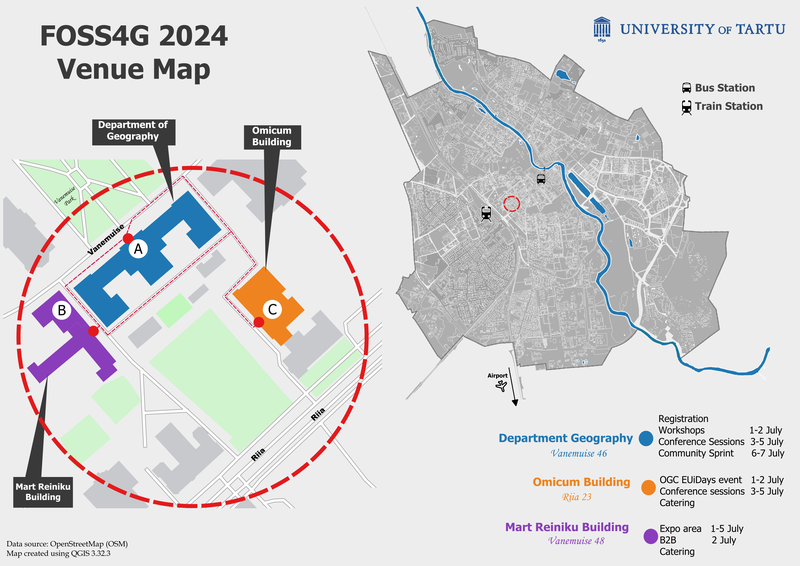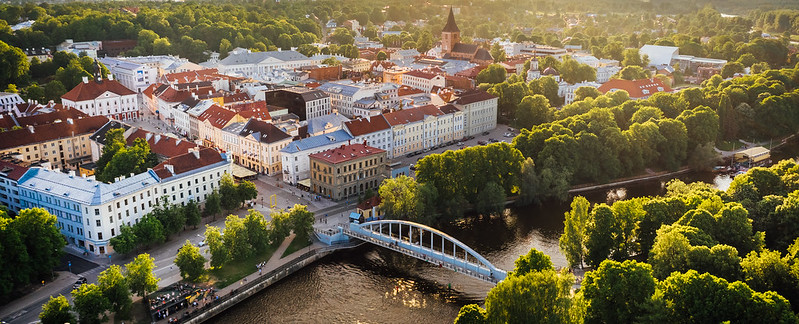The conference venue is divided between 3 different buildings which are located nearby to each other. The main events of the conference (registration, workshops, conference sessions and community sprint) take place in Vanemuise 46, the Department of Geography.
Catering will be divided between 2 other buildings - Mart Reiniku and Omicum, choose the building whichever is more comfortable for you at the moment. Omicum building also hosts the OGC EUiDays event on the first 2 days of the week.
Mart Reiniku building hosts also the expo area throughout the week and B2B event on 2 July.
All the other venues for the social events can be found on the interactive map from the footer of the home page.

Map of the conference venue. Click to see a hi-res version. Map by Pamela Guaman Pintado
The venue of the main conference will be the home of the UT Department of Geography at Vanemuise 46, Tartu.

Venue of the conference. ©Andres Tennus via Department of Geography
About Tartu
Tartu is situated in Southern Estonia. The capital city of Estonia is Tallinn which is 180 km to the North-West. It lies about halfway down the stream on the banks of river Emajõgi, one of the largest rivers of Estonia connecting the lakes Võrtsjärv and Peipsi. Tartu is an old historic region (historically also known as Tarbatu, or Dorpat) and was first mentioned by medieval chroniclers in 1030.
With a population of 100K, it is the second largest city in Estonia, and home to multiple universities (including the University of Tartu established in 1632), and is often referred to as the “intellectual capital city” of Estonia.
Tartu is also home to the Ministry of Education and Research, the Estonian National Museum, the Supreme Court of Estonia, and theatre Vanemuine - the oldest Estonian-language theater in Estonia. Tartu is also the focal point of Estonia’s active technology sector as well as a hotbed of IT development and start-ups.

Aerial view to the city centre. ©Kaarel Kõvatu via visittartu.com
Everything in Tartu is within a 10-20 minute walking distance and therefore you do not need a car nor public transport to get around to most places. In addition, Tartu has a very efficient bike-share system which also gets to the suburbs of Tartu.
At every corner in Tartu, there are concert venues, exhibition halls, theatres, churches, museums and charming little cafés as well as various pubs and restaurants. An inseparable part of the city is its students who comprise around a quarter of the population and generate a lot of fun and energy.
In 2024, Tartu will be one of the European Capitals of Culture, so we expect a lot to be happening in the city in the weeks leading up to, during, and after FOSS4G Europe 2024. Some of the hand-picked activities by the LOC are available HERE
About Estonia
- The Republic of Estonia is situated in Northern Europe along the Baltic Sea and has approximately 1.3 million inhabitants.
- The official language is Estonian.
- Estonia has a membership in the European Union, Schengen Area, WTO, NATO and OECD.
- Currency is euro (since 2011)
- For visa-related questions, please visit the website of Estonian Ministry of Foreign Affairs. The Government of the Republic of Estonia has approved a sanction imposing a restriction on citizens of the Russian Federation and the Republic of Belarus applying for an Estonian visa.